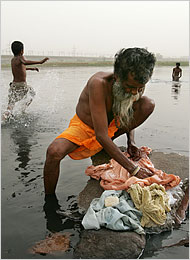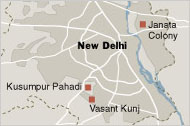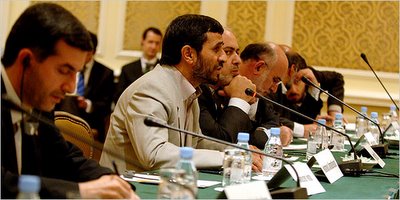GEORGE FOREMAN — bald, smiling and gigantic — is propped atop a stool in Gleason’s Gym, the venerable boxing haunt in Brooklyn, watching a videotape of his heavyweight championship bout in 1994 with Michael Moorer.
Mr. Foreman once devastated opponents with brutal, staccato punches short on artistry and long on force. He disposed of formidable pile drivers like Joe Frazier, traded blows with dangerous magicians like Muhammad Ali, and dropped the undefeated 26-year-old Mr. Moorer in the 10th round with a right to the jaw.
Mr. Foreman was 45 at the time of the Moorer fight, a roly-poly 250-pounder who had just reclaimed the heavyweight mantle that Mr. Ali had snatched from him 20 years earlier. By knocking out Mr. Moorer, Mr. Foreman became the oldest heavyweight champion in history and he hailed his victory at the time as one “for all my buddies in the nursing home and all the guys in the jail.”
As Mr. Foreman watches the tape of Mr. Moorer crumpling to the mat, part of a boxing retrospective that ESPN is shooting at Gleason’s, he beams. “Play that again,” he says to no one in particular, softly chuckling to himself. The knockout was the culmination of an unlikely return to the ring that Mr. Foreman staged in his later years, well after he had retired. He has often said that he ended his retirement to prove that nobody is too old for a comeback.
But Mr. Foreman confides in an interview that something else actually drove him back into boxing in the late 1980’s, and it had nothing to do with proving the meaninglessness of an AARP card. Having blown about $5 million, made mostly, he says, during his salad days as a young champion, he desperately needed the money he could earn by fighting again. A former street thug from Houston, accustomed to dispassionately cutting down the most ferocious of men, Mr. Foreman was on the verge of bankruptcy in the 1980’s — and it terrified him.
“It was frightening, the most horrible thing that can happen to a man, as far as I am concerned,” he says. “Scary. Frightening. Nervous. I had a family, people to take care of — my wife, my children, my mother. I haven’t gotten over that yet.”
Pondering his glimpse into the abyss a moment longer, Mr. Foreman’s eyes tighten: “It was that scary because you hear about people being homeless and I was only fractions, fractions from being homeless.”
UNLIKE many others with lush bankrolls who somehow manage to lose it all, Big George rebounded handsomely from his flirtation with bankruptcy. He earned multimillion-dollar purses boxing in the 1990’s and made tens of millions more by reinventing himself as a gentle entrepreneur, astutely peddling the best-selling hamburger grills that bear his name.
Even so, the trajectory of Mr. Foreman’s finances once had him headed into a gilded pantheon of big buckaroos who have squandered often-unimaginable sums of money, come perilously close to personal bankruptcy or completely lost their shirts. The ranks of well-heeled debtors include Thomas Jefferson, Buffalo Bill Cody, Mark Twain, Ulysses S. Grant, Debbie Reynolds, Michael Jackson, Dorothy Hamill, Robert Maxwell, Mike Tyson, Jack Abramoff and a long and pitiful cast of lottery winners.
Each of these grandees had distinct encounters with errant money management. Some of them were undone by rampant spending, others by injudicious deal-making, still others by various shades of greed, fraud or spectacularly poor investments. All of which gives rise to the same old set of questions: Why can’t those who are already wealthy restrain themselves from spending more than they have? Why do rich people, those who would seem to have all the financial padding one needs, wind up deeply in debt? Even worse, why do some of them end up broke?
Mr. Foreman, street-smart and now mindful of his wallet, has his own perceptive answers to those questions. For the man who came back from the brink, it’s all a matter of discipline and proper boundaries.
“A lot of people just don’t grow up,” he says. “I mean, 65-year-old men. They just don’t grow up. They don’t understand that money does not grow on a tree and that you’ve got to respect every dollar. Like Rip Van Winkle — the guy who slept — they party, party, party, then they wake up. ‘Oh my God!’ And they do something desperate trying to recapture what they had. And it doesn’t work like that. You must stay awake.”
David W. Latko, a money manager and radio host who recently published “Everybody Wants Your Money” (HarperCollins), a personal finance primer, reduces the mechanics of squandered wealth to handy categories. He says there are five basic ways people become rich: they inherit, marry, steal, win or earn their fortunes. Only those who earn fortunes, says Mr. Latko, tend to preserve their wealth. Inhabitants of the other four categories are more prone to be wastrels.
“The first thing you’ve got to look at, always, is where is the money coming from,” he says. “People who’ve made money themselves protect it. People who’ve inherited it spend it.”
Profiles of wealthy debtors may not be quite as tidy as Mr. Latko’s list suggests; self-made gazillionaires can wind up insolvent, too, particularly if they earn their money in celebrity circuses like Hollywood. But by and large, Mr. Latko’s list rings true and reinforces one of Mr. Foreman’s points: America’s rich, it would seem, sometimes do believe that money grows on trees.
In some of the darker scenes in Frank Capra’s 1946 cinematic parable about family, community and money, “It’s a Wonderful Life,” Uncle Billy, a kindly, pastoral fogy whose bank office is routinely visited by crows and squirrels, misplaces a hefty deposit that threatens to upend the Bailey family’s little savings-and-loan. Billy’s nephew, George Bailey, played by that symbol of middle-American rectitude, James Stewart, warns his uncle of the consequences of a bank collapse that also promises to force the Bailey family into debt.
“Where’s that money?” George screams at his uncle, growing more frantic by the second. “Do you realize what this means? It means bankruptcy and scandal and prison!” Later rescued from suicide and shame by a bumbling angel and generous townsfolk who kick in hatfuls of cash around the Bailey family’s Christmas tree, George gets smooches from his lovely wife and a new lease on life.
In our more modern financial era, fueled by credit card debt, home equity loans and myriad other forms of handy spending money, George Bailey’s predicament strikes us as, perhaps, quaint. When people like the former baseball commissioner Bowie Kuhn — who earned a handsome salary overseeing the national pastime before his law firm collapsed in bankruptcy in 1990 — decamp to manses in Florida to take advantage of state laws that prevent creditors attaching expensive homes, George Bailey’s fear of ostracism rings old-fashioned.
Over the last three decades, personal bankruptcy rates in America have soared. But in a nod to the notion that going belly-up still carries a whiff of disrepute, Congress tightened bankruptcy laws last year to circumvent what Senator Orrin G. Hatch, Republican of Utah, decried as “a way to avoid personal responsibility.”
It may be, however, that for most people, a bankruptcy filing simply marks an inability to stay afloat — not an attempt to dodge creditors — because most of those who lose their shirts typically are not rich.
According to a study by the St. Louis Federal Reserve last fall, most bankruptcy filers are blue-collar, lower-middle-class high school graduates who are already overloaded with debt when they get sideswiped by unforeseen miseries like a job loss or overwhelming medical expenses. Rarely do the rich have to ponder the consequences of layoffs or insurmountable hospital bills, yet the social ledger is chock-full of examples of landed gentry who still dissipate their wealth and run the risk of ignominy.
Buffalo Bill hauled in the equivalent of about $30 million in today’s dollars overseeing his Wild West show at Chicago’s Columbian Exposition in 1893, according to Erik Larson’s book “The Devil in the White City.” A financial panic in 1907 ruined him and his show; when he died in 1917 there wasn’t enough money in his till to pay for his burial.
Mark Twain, who had a lifelong penchant for dodgy investments and gimmicky inventions, lost about $4 million in today’s dollars betting on a newfangled but unwanted typesetting machine in the 1890’s. He subsequently had to take to the lecture circuit to stave off bankruptcy.
Michael Jackson, who began churning out Top 10 songs and albums as the lead singer of the Jackson 5 before reaching puberty, found it necessary to pledge a stake in his lucrative songbook of Beatles hits to secure a $270 million bank loan to forestall a slide into bankruptcy.
Mike Tyson, like Mr. Jackson a gifted man-child, is entangled in his own financial woes despite once having the marquee power to draw $30 million purses for a single fight. When Mr. Tyson filed for bankruptcy in 2004, he listed debts of $27 million, including about $13 million in unpaid federal taxes and about $174,000 for a diamond-studded gold chain. He had maintained a monthly budget of about $400,000 before the filing.
Buffalo Bill, Michael Jackson, Mike Tyson, Wayne Newton, Burt Reynolds, Elton John and other public examples of spending run amok were, or are, all entertainers, and entertainers offer ready fodder for tsk-tsking — largely because gossip columns make it easy for the rest of us homely paupers to take quiet satisfaction in their plight. Entertainers, for the most part, are also peculiarly vulnerable when it comes to personal finance.
“You have people who are struggling for a long time and then overnight, boom, they hit it,” says Shelley Finkel, Mike Tyson’s manager. “If they don’t have someone watching out for them, and some emotional stability, it will be very hard for them to be grounded financially.”
MR. FINKEL, a genial, elfin 62-year-old New Yorker who began his own career promoting a A-list rock stars like Jimi Hendrix, said he had always advised musicians and athletes to protect their wealth by socking away a chunk of their earnings into annuities or pensions. Few of them have heeded that advice, he said, including Mr. Tyson, who Mr. Finkel believes earned and lost more than $400 million in his boxing career.
“It’s very hard to tell them ‘Don’t!’ because they love the instant gratification,” Mr. Finkel says. “I think the human in general is vulnerable and whatever their weakness is it’s going to get exploited, particularly around money.”
Mr. Foreman, unlike most entertainers and athletes, had homegrown financial antennae, and his budgetary acumen surfaced at a relatively early age. He slugged his way into prominence by winning a gold medal at the 1968 Olympics, and a year later, when he was 20, he turned pro. Schooled, he said, in the perils of errant spending by the financial predicament of the boxing legend Joe Louis, he decided to form the George Foreman Development Corporation in 1971.
“I had so much time alone,” he recalls. “Not many people thought I would be champ of the world. Didn’t have any friends at all. And what I would do is walk to the bookstore, and I’d buy books. And they were books on taxes, accrual taxes, estimated taxes, and you better make a corporation.”
Mr. Foreman says his homework persuaded him to put about 25 percent of what he earned at every bout into a pension and profit-sharing plan controlled by his corporation. “I had all this time dreaming of this, so that when money came upon me I was already prepared,” he says.
Despite how closely Mr. Foreman tended his nest egg, most of his assets remained exposed. He describes the way he invested his unencumbered cash, about $5 million, as a series of blunders: “Oil wells, gas wells, banks, flop, flop, flop.”
Entertainers aren’t the only rich people with holes in their pockets. Business people, seemingly prepared to have a better handle on their balance sheets than celebrities, have wound up as big debtors as well. William Randolph Hearst, of the publishing empire, the San Simeon estate and a 280-foot yacht, stood at the edge of insolvency in the late 30’s. John Z. DeLorean, Motor City dream weaver and inventor of a streamlined sports car that bore his name, filed for bankruptcy in 1999 after financial and legal problems.
Questioned in 1991 about the reasons rich people hit the skids, the multibillionaire investor Warren E. Buffett told an audience at Notre Dame that debt and alcohol were ever-present culprits in financial demise. “I’ve seen more people fail because of liquor and leverage — leverage being borrowed money,” he said, according to a transcript of his comments. “You really don’t need leverage in this world much. If you’re smart, you’re going to make a lot of money without borrowing.
“I’ve never borrowed a significant amount of money in my life. Never,” he added. “Never will. I’ve got no interest in it. The other reason is I never thought I would be way happier when I had 2X instead of X.”
Yet even the most well-to-do sometimes still rely on debt. Over the years, Lawrence J. Ellison, founder and chief executive of Oracle, has preferred to hold onto, rather than sell, his shares in the database provider, giving him a stake currently valued about $17.6 billion.
Oracle shares represent almost the entirety of Mr. Ellison’s fortune, and to finance one of the country’s splashiest spending sprees (454-foot megayacht, mansions, expensive hobbies and more) he has occasionally taken on sizable bank loans rather than sell his shares — all on the presumption that the value of his shares will remain lofty enough to allow him to pay back the loans.
A RAFT of e-mail messages and financial documents introduced in a lawsuit that disgruntled shareholders filed against Mr. Ellison and other Oracle executives in 2001, give witness to some of Mr. Ellison’s budgeting practices. (The suit was settled last November and the judge in the matter subsequently unsealed financial documents submitted as exhibits in the case). The documents, first reported by The San Francisco Chronicle earlier this year, also show how far Philip E. Simon, an adviser who described himself as Mr. Ellison’s “financial servant,” went in trying to persuade his boss to pay off about $1.2 billion in loans. (Neither Mr. Ellison nor Mr. Simon responded to interview requests for this article).
Mr. Ellison’s ledger around the end of 2000 included annual “lifestyle” spending of about $20 million, the purchase of a Japanese villa for $25 million, a proposed underwater archeology project earmarked for $12 million and his new yacht, budgeted at $194 million (news reports later said that the yacht’s final cost approached $300 million).
“I know you view me as a pessimist,” Mr. Simon wrote Mr. Ellison in an e-mail message in 2002, several months after banks began sounding alarms about Mr. Ellison’s debt. “Maybe you’re right, though I would disagree. Nonetheless, I think it’s imperative that we start to budget and plan. New purchases should be kept to a minimum. We need to establish and execute on a diversification plan to eliminate (yes, eliminate) all debt and build up a significant, conservatively structured, liquid investment portfolio.
“I know you don’t like to discuss this,” Mr. Simon added. “I know this e-mail may/will depress you. View this as a call to arms.”
Mr. Ellison paid down a portion of his debt by 2002, according to court filings, and his Oracle holdings are vast enough that it was unlikely that his financial well-being was ever in peril. But for lesser financial potentates, the psychological twists behind overspending and bad investing can be more debilitating.
“The rich are different from you and me: they are more egotistical,” says Theodore R. Aronson, managing principal of Aronson Johnson Ortiz, an investment firm in Philadelphia. “Psychologically, I think the rich, because of their egos, think they know everything. Well, they don’t, and many of them repeatedly make horrible investments — because they can.”
Financial success can breed its own peculiar set of vulnerabilities. “People who are very successful develop elevated sensibilities about their skills, and when things turn on them they won’t admit they’re wrong because their self-confidence has held them up so long,” says Arnold S. Wood, chief executive of Martingale Asset Management in Boston. “In the face of evidence, even subjective evidence, that suggests that something bad is about to happen to someone, a funny thing happens: They reject the evidence.
“These kinds of people just continue spending because they think the money will keep coming in because they’re so successful,” adds Mr. Wood, who says he is fascinated by the possible neurological and social underpinnings of financial delusion and decision-making. He believes that gender plays a strong role in financial ruin because, he says, women tend to be more risk averse than men when it comes to money. Some interesting research backs this up.
Brad M. Barber and Terrance Odean, two business professors at the University of California, Berkeley, noted in an analysis in 2001 of stock trading, “Boys Will Be Boys,” that psychological studies demonstrated that men tended to be more overconfident than women. Financial data supported the same point. “Models of investor overconfidence predict that men will trade more and perform worse than women,” the professors’ study concluded.
Dig a little deeper into this psychological terrain, and, alas, the financial deck may be stacked beginning in childhood, regardless of sex. Kathleen Gurney, a “financial psychologist” who advises wealthy people trapped in monetary crises, said that the social milieu in which people grew up, the early messages they received about money and their individual emotional makeup all conspired to define how well they handled money as an adult.
America’s consumer landscape, which prizes spending and encourages people to define themselves by what they own, only makes the financial balancing act trickier for adults, especially if they have fat wallets.
“Someone who goes broke, or someone who goes into debt, is really somebody who isn’t comfortable having their money,” Ms. Gurney says. “Yes, it appears as a lack of discipline. But the lack of discipline comes from an emotional place that causes them to be undisciplined. It’s not about the money. It’s about our emotional relationship to money.
“The people who are out there just running through money have failed because they haven’t come to terms with who they are and what they want the money to do for them,” she adds. “I see a lot of baby boomers beginning to panic because they haven’t figured this out.”
Mr. Foreman, who stared down financial collapse as an adult despite a troubled, impoverished childhood, said he knew real wealth when he saw it. “If you’re confident, you’re wealthy,” he says. “I’ve seen guys who work on a ship channel and they get to a certain point and they’re confident. You can look in their faces, they’re longshoremen, and they have this confidence about them.”
He says he can spot a longshoreman who has enough equity in his home and enough money in the bank to feel secure, and that some people, no matter how much money they have, never get there. “I’ve seen a lot of guys with millions and they don’t have any confidence,” he says. “So they’re not wealthy.”
IN the years after the Moorer fight, Mr. Foreman became much wealthier than he ever was during his boxing career. In 1999, he sold his name and his image to the manufacturer of George Foreman’s Lean Mean Fat-Reducing Grilling Machine for $137.5 million in cash and stock. He is now a proven pitchman on home shopping channels and the lecture circuit. He owns a fleet of cars, a watch collection, two homes and a ranch in Texas, and another home on the Caribbean island of St. Lucia — but he says he has no idea what his net worth is, and he says he does not want to know.
“When you start knowing, you’re scared,” he says. “I have lots of money, you know what I mean? But I haven’t found confidence like that longshoreman I told you about.” Nearly going bankrupt, he asserts, has permanently scarred him. “I will never feel secure again,” he says. “I’ve got to earn, earn, earn, earn.”
Respect every dollar, Mr. Foreman reiterated, respect every dollar.
“You can become complacent,” he says. “You can say, ‘I’m successful,’ which is the kiss of death. In America it’s hard to wake up hungry. It’s frightening. You can become complacent and wake up tomorrow totally homeless.”
 Consider the parallels. The perpetrators of this spectacular assault were not in the pay of any foreign power: no nation would have dared to attack Rome so provocatively. They were, rather, the disaffected of the earth: “The ruined men of all nations,” in the words of the great 19th-century German historian Theodor Mommsen, “a piratical state with a peculiar esprit de corps.”
Consider the parallels. The perpetrators of this spectacular assault were not in the pay of any foreign power: no nation would have dared to attack Rome so provocatively. They were, rather, the disaffected of the earth: “The ruined men of all nations,” in the words of the great 19th-century German historian Theodor Mommsen, “a piratical state with a peculiar esprit de corps.”








